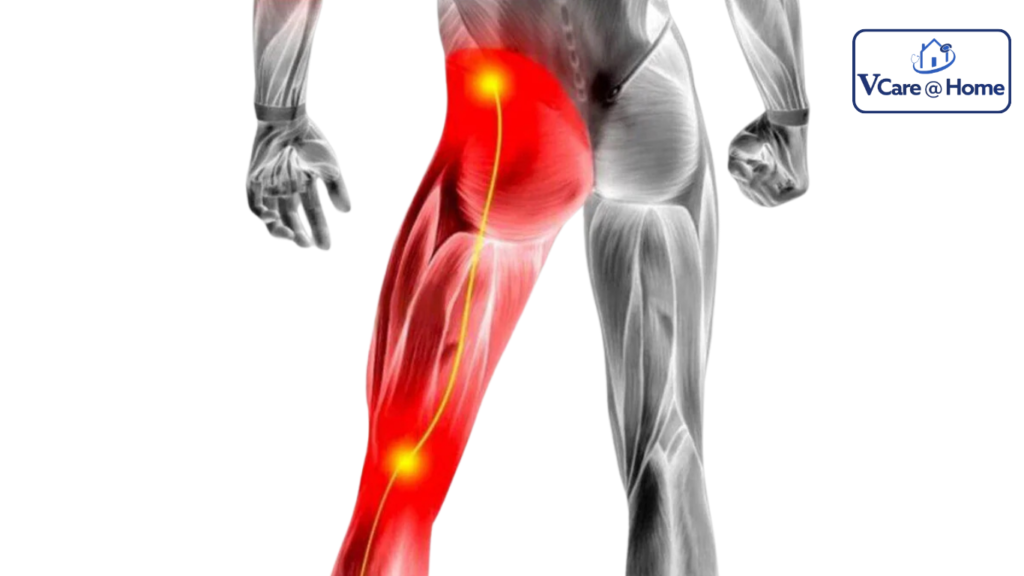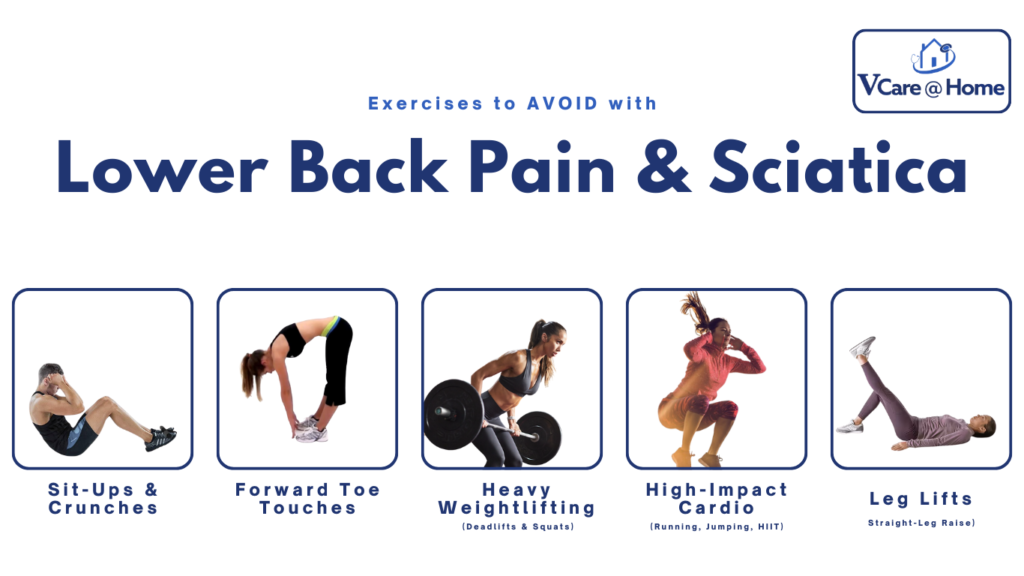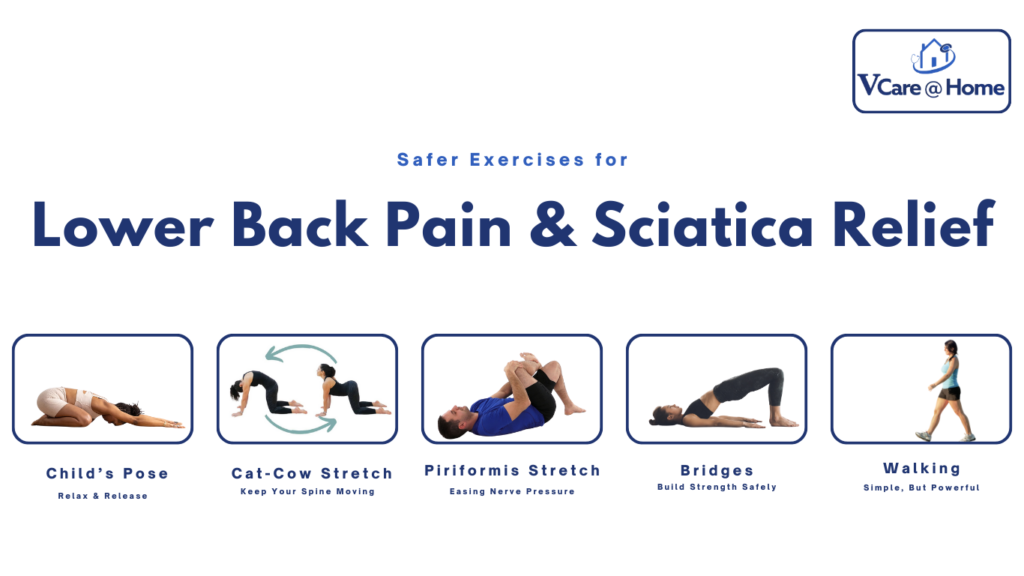
If you’ve ever struggled to get out of bed because of sharp back pain shooting down your leg—you know how disabling Lower Back Pain and Sciatica can be. It’s not just about the pain; it’s about how it steals your comfort, your sleep, and even the simple joy of moving freely. Millions of people around the world are fighting this same battle every single day, so if you’re going through it, please know—you’re not alone.
Here’s the tricky part: while exercise can be one of the best ways to find relief, the wrong kind of movements can actually make Lower Back Pain and Sciatica worse. That’s why it’s so important to know which exercises for lower back pain and which exercises for sciatica are safe—and which ones to completely avoid.
In this blog, we’ll walk through the top 5 exercises you should stay away from, the safer alternatives that can help you heal, and answers to the most common questions people like you have. Think of this as a friendly guide that gives you both the information and reassurance you need to move forward with confidence—because recovery is possible.
Understanding Lower Back Pain and Sciatica
If you’ve ever felt that nagging ache in your lower back or a sharp pain running down your leg, you know how frustrating it can be. Lower Back Pain and Sciatica are two of the most common reasons people struggle with daily activities, yet many of us don’t really understand what’s happening inside our body. Let’s break it down in the simplest way possible so you know what’s going on—and how to avoid making it worse.
What is Lower Back Pain?

Lower back pain is exactly what it sounds like—pain or stiffness in the lower part of your spine. But here’s the thing: not all back pain is the same.
Sometimes it comes from something simple, like sitting in a bad posture for too long or lifting something heavy the wrong way. Other times, it’s because of deeper issues such as:
- Muscle strain – when your muscles get overstretched or torn.
- Poor posture – sitting hunched over a laptop or phone.
- Herniated disc – when the cushion between your spinal bones slips out of place.
- Degeneration with age – as we grow older, the spine naturally loses some of its strength.
For many people, lower back pain can feel like a dull ache, while for others, it’s sharp and severe enough to stop them from doing even simple tasks like bending, walking, or getting up from bed.
What is Sciatica?

Now, Sciatica is a bit different from ordinary back pain. Imagine a big nerve—the sciatic nerve—that starts in your lower back and runs all the way down through your hips, buttocks, and legs. When this nerve gets compressed or irritated, the pain doesn’t just stay in your back. Instead, it shoots down one leg, sometimes reaching as far as your foot.
People with sciatica often describe it as:
- A burning or shooting pain down the leg.
- Tingling or numbness in the thighs, calves, or feet.
- Weakness in the affected leg.
The most common reasons for sciatica are a herniated disc, spinal stenosis (narrowing of the spinal canal), or even muscle tightness that presses on the nerve. Unlike regular back pain, sciatica feels more like electricity running down your body—and it can be very disabling if not managed properly.
Why Certain Exercises Make It Worse
Here’s something most people don’t realize: not all exercises for lower back pain are good for you—especially if you also have sciatica. In fact, some movements can actually make things worse.
When you do exercises that put too much pressure on your lumbar spine (the lower part of your back) or stretch the sciatic nerve in the wrong way, the pain can flare up. For example:
- Heavy weightlifting – squats or deadlifts with poor form can compress the spine.
- High-impact workouts – running on hard surfaces can jar the lower back.
- Twisting movements – like certain yoga poses that rotate the spine too deeply.
- Deep forward bends – can overstretch the sciatic nerve.
That’s why it’s so important to learn which exercises for sciatica or back pain are safe, and which ones you should avoid. The goal isn’t to push through the pain but to move in ways that support healing.
5 Exercises to AVOID with Lower Back Pain & Sciatica

If you’re dealing with lower back pain or sciatica, I know how frustrating it can feel. Some days even simple things like sitting, standing, or bending can feel like a challenge. And the truth is—while exercise is an important part of recovery, not every movement is safe for your back. In fact, some “common” exercises can make your pain worse without you even realizing it.
So, let’s clear the confusion. Below, I’ll share 5 exercises you should avoid if you have lower back pain or sciatica—and most importantly, I’ll give you safe alternatives that can help you stay active without worsening your condition.
Think of this as a guide from a caring friend who wants to make sure you heal the right way, without setbacks.
1. Sit-Ups & Crunches
Why to Avoid:
Sit-ups and crunches are often promoted as “core strengthening” exercises, but if you’re dealing with sciatica or lower back pain, they do more harm than good. These movements put a lot of pressure on the spinal discs. If you already have a bulging or herniated disc (a common cause of sciatica), sit-ups can worsen the irritation on your sciatic nerve. That’s why many people feel sharp pain shooting down the leg after doing crunches.
What to Do Instead:
Instead of sit-ups, go for pelvic tilts or gentle planks (starting with modified planks on your elbows and knees). These exercises strengthen your core without putting direct stress on your spine. A strong core is like a protective belt for your lower back—it keeps your spine stable and helps reduce future flare-ups.
2. Forward Toe Touches
Why to Avoid:
You’ve probably seen this one in school workouts—standing up and bending forward to touch your toes. Sounds harmless, right? Not when you have lower back pain or sciatica. Forward bends put extra pressure on your spinal discs and overstretch your hamstrings. This pulls on the sciatic nerve, which can make the pain shoot down your leg even more.
What to Do Instead:
Go for gentle hamstring stretches while lying on your back. For example, use a towel or resistance band to support your leg and stretch without forcing the movement. This way, you get the flexibility benefits without triggering nerve pain.
3. Heavy Weightlifting (Deadlifts & Squats)
Why to Avoid:
Deadlifts and heavy squats might be great for athletes, but they’re not your friend if you’re struggling with sciatica or lower back pain. These exercises compress the spine, increase inflammation, and can worsen nerve irritation. Even if you use perfect form, the load on your lower back may still be too much during recovery.
What to Do Instead:
Swap the heavy barbell for light resistance bands or bodyweight strengthening. Simple moves like mini-squats, wall sits, or gentle hip bridges give you strength training benefits without putting dangerous pressure on your back. Remember—the goal isn’t lifting heavy, it’s healing safely.
4. High-Impact Cardio (Running, Jumping, HIIT)
Why to Avoid:
When you’re in pain, sometimes people tell you “just go for a run.” But running, jumping, or high-intensity interval training (HIIT) is too harsh on your lower back and sciatic nerve. The constant pounding and jarring movements act like tiny shocks to your spine. Over time, this increases irritation and slows down recovery.
What to Do Instead:
Switch to low-impact exercises like swimming, cycling, or even brisk walking. These movements keep your heart healthy, improve circulation, and help you stay active—without putting extra stress on your spine. Swimming, especially, is like therapy for the back because the water supports your body weight.
5. Leg Lifts (Straight-Leg Raise)
Why to Avoid:
The straight-leg raise might look simple, but it directly tugs at the sciatic nerve and strains the lower back. Many people with sciatica notice a sharp pull or burning pain when trying this exercise. Doing it repeatedly can actually worsen the irritation in the nerve.
What to Do Instead:
Try bent-knee leg lifts or glute bridges. When your knees are bent, the pressure on your lower back is much less, and you can still strengthen your core and glutes. Glute bridges, especially, are wonderful for improving stability in your lower back.
Need Professional Physiotherapy at Home?
Get expert care from our best team. We are the leading Physiotherapy Services provider in these locations.
Safer Exercises for Lower Back Pain & Sciatica Relief

If you’ve ever struggled with lower back pain or sciatica, you already know how much it can take away from your daily life. Simple things—like bending down, sitting too long, or even getting out of bed—can feel like a challenge. The truth is, movement is not your enemy. In fact, gentle, safe exercises for lower back pain and exercises for sciatica are often one of the best ways to start healing.
But here’s the key: not every exercise is safe. The wrong moves can actually make the pain worse. That’s why it’s important to focus only on movements that support your spine, ease pressure on the nerves, and build strength gradually.
Let’s walk through some of the safest and most effective exercises that have helped countless people find relief.
1. Child’s Pose – Relax & Release
Think of this as a reset button for your back. Child’s Pose is a gentle stretch that lengthens the spine and releases built-up tension.
- How to do it: Kneel on the floor, sit back on your heels, and slowly stretch your arms forward while lowering your chest toward the ground.
- Why it helps: It gives your spine a gentle stretch without strain, perfect for easing discomfort in lower back pain and calming sciatica flare-ups.
2. Cat-Cow Stretch – Keep Your Spine Moving
Your spine loves movement, but only the right kind. The Cat-Cow stretch keeps your back flexible while encouraging blood flow.
- How to do it: Start on your hands and knees. Inhale as you arch your back (cow), and exhale as you round it gently (cat).
- Why it helps: This simple motion reduces stiffness and keeps the spine mobile, which is important when you’re dealing with sciatica or stiffness from back pain.
3. Piriformis Stretch – Easing Nerve Pressure
Did you know there’s a small muscle deep in your hips called the piriformis? When it gets tight, it can press on the sciatic nerve and trigger that sharp, radiating pain.
- How to do it: Lie on your back, bend your knees, and cross one ankle over the opposite knee. Pull the lower knee gently toward your chest.
- Why it helps: This stretch releases pressure on the sciatic nerve, often giving almost immediate relief for people struggling with sciatica pain.
4. Bridges – Build Strength Safely
Strength is just as important as stretching. Bridges target the glutes and lower back muscles, which support your spine.
- How to do it: Lie on your back with your knees bent and feet flat on the floor. Slowly lift your hips upward, hold for a few seconds, and then lower down.
- Why it helps: Strong glutes and core muscles take pressure off your lower back, making everyday movements safer and less painful.
5. Walking – Simple, But Powerful
It may sound too easy, but walking is one of the most underrated exercises for sciatica and lower back pain. Gentle walking increases circulation, loosens stiff muscles, and improves overall posture.
- How to start: Begin with short 5–10 minute walks on even ground. Increase your time as your body allows.
- Why it helps: It keeps your body moving without putting extra strain on your spine.
A Gentle Reminder: Exercise the Right Way
When you’re living with lower back pain or sciatica, it’s natural to feel afraid of moving too much. But avoiding all activity can actually slow down recovery. Gentle movement is not just safe—it’s necessary. The secret lies in choosing the right exercises and listening to your body.
Here are a few tips to keep in mind:
- Stop immediately if a movement causes sharp or shooting pain.
- Start slow, and increase only when your body feels ready.
- Consistency matters more than intensity—just 10–15 minutes daily can make a big difference.
- Pair exercise with good rest, proper posture, and hydration for faster healing.
Why This Matters for You
Pain can make you feel helpless, like you’ve lost control of your own body. But these simple, safe movements give you that control back. Each stretch and exercise is like telling your body: “I’m helping you heal.”
With patience and the right approach, many people find that their pain gradually lessens, mobility improves, and life begins to feel normal again.
Remember—you don’t have to push through pain or do anything extreme. Just gentle, steady progress is enough. Healing is possible, and it starts with small, safe steps.
Tips to Exercise Safely with Lower Back Pain & Sciatica
Dealing with Lower Back Pain and Sciatica can feel frustrating. Some days you may be eager to move, but the fear of pain holds you back. And honestly, that fear is valid—because the wrong movement can make things worse. But here’s the good news: with the right approach, gentle movement and the right exercises can actually bring relief, improve strength, and help you feel more in control of your body again.
Here are some simple yet powerful tips to keep in mind when exercising with Lower Back Pain or Sciatica:
1. Warm Up Properly
Think of your body like a car on a cold morning—you wouldn’t just start driving at full speed without warming it up first, right? The same goes for your back. A short 5–10 minute warm-up, like slow walking, gentle stretches, or breathing exercises, helps prepare your muscles and reduces stiffness. When you warm up, you’re basically telling your spine, “Relax, I’m going to take care of you.”
2. Listen to Your Body—Don’t Push Through Pain
This is probably the most important tip. Pain is your body’s way of saying “something isn’t right.” If you feel a sharp, shooting, or burning sensation while doing exercises for Lower Back Pain or Sciatica, stop immediately. Gentle discomfort is fine, but pain is a red flag. Remember, you’re not in a race—you’re on a journey to heal. So be kind to yourself and move at your own pace.
3. Maintain Proper Posture & Core Stability
Posture plays a huge role in back health. Slouching or twisting your spine while exercising can put extra pressure on the nerves that are already irritated by Sciatica. The key is to keep your back neutral and engage your core muscles while you move. Think of your core as a natural belt that supports your spine—keeping everything stable and safe. Even simple exercises like bridges, gentle stretches, or pelvic tilts can work wonders if done with the right posture.
4. Consult a Physiotherapist Before Trying New Exercises
Every back condition is unique—what works for one person may not work for another. That’s why getting guidance from a trained physiotherapist is so important. They can suggest exercises for Lower Back Pain and Sciatica that are safe for your specific condition, and teach you the right way to do them. This not only speeds up recovery but also prevents future flare-ups.
Conclusion – Protect Your Back, Protect Your Future
So, let’s take a moment and recap. We’ve talked about 5 exercises you should avoid if you’re struggling with lower back pain or sciatica. These are the moves that might look harmless, but in reality, they can make your condition worse—putting extra stress on your spine, irritating nerves, and slowing down your recovery.
But here’s the good news: protecting your back isn’t about giving up movement. In fact, it’s the opposite. Your body loves gentle, safe, and low-impact exercises that strengthen muscles without straining them. Think of it as giving your back the kind of support it truly deserves—support that helps you heal instead of hurt.
And remember, pain is not just physical—it’s emotional too. When you can’t bend properly, sit for long, or even sleep peacefully, it takes away your comfort, your mood, and sometimes even your confidence. That’s why caring for your back is not just about today—it’s about your future.
👉 Your back deserves care, patience, and the right movements. Protect it today, so it supports you for years to come.
If you’re unsure about which exercises for lower back pain or exercises for sciatica are safe for you, don’t guess. Every spine, every body, and every injury is different. What works for one person might not work for another.
That’s why the best step you can take is to consult a physiotherapist or a trusted home healthcare provider. With expert guidance, you’ll get a plan that’s personalized for your condition—helping you stay active, recover faster, and prevent future flare-ups.
You don’t have to live with constant lower back pain or the shooting discomfort of sciatica. With the right care, safe movements, and a little patience, you can reclaim your comfort and strength—one step at a time.
FAQs on Lower Back Pain & Sciatica Exercises
- Can I still exercise if I have sciatica?
Yes, but choose low-impact exercises and avoid movements that trigger pain. - Are stretches safe for sciatica?
Gentle stretches help, but avoid forward bending and jerky movements. - Is walking good for lower back pain and sciatica?
Yes, walking improves circulation and reduces stiffness. - Should I completely stop exercising during sciatica pain?
No, complete rest can worsen stiffness. Gentle, safe movement is best. - When should I see a doctor for back pain?
If pain lasts more than a few weeks, worsens at night, or causes numbness/weakness. - Are yoga poses safe for sciatica?
Some (like child’s pose) are beneficial, but avoid deep forward bends.


























